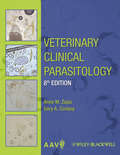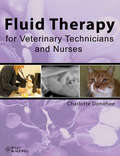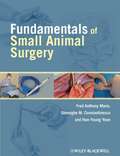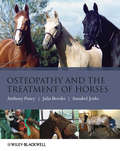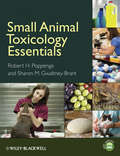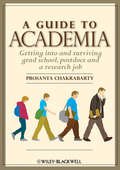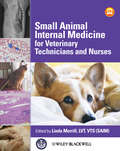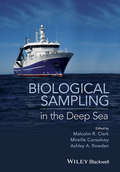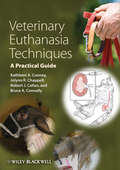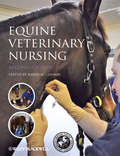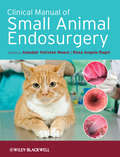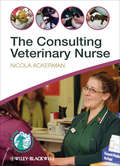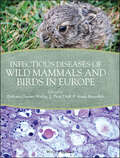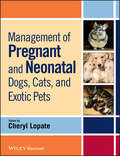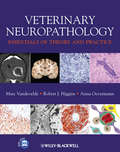- Table View
- List View
Veterinary Clinical Parasitology
by Anne M. Zajac Gary A. ConboyVeterinary Clinical Parasitology, Eighth Edition, prepared under the auspices of the American Association of Veterinary Parasitologists (AAVP), emphasizes the morphologic identification of both internal and external parasites of domestic animals. Focusing on the tests and information most relevant to daily practice, the book describes accurate, cost-effective techniques for diagnosing parasitic infections in animals. Including clear, easy-to-find information on the distribution, life cycle, and importance of each parasite, Veterinary Clinical Parasitology offers more than 450 images to aid with diagnosis. The Eighth Edition includes a new chapter on immunologic and molecular diagnosis, increased coverage of ticks and new sections on identification of microfilariae and larvae in diagnostic samples. The new edition also features expanded information on quantitative egg counts, detection of anthelmintic resistance and identification of ruminant strongylid larvae. Additional improvements include many new images throughout the book, revised taxonomic information, a new layout featuring tabs by section to improve user-friendliness, and a companion website offering the images from the book in PowerPoint at www.wiley.com/go/zajac. Veterinary Clinical Parasitology is a highly practical benchside reference invaluable to clinicians, technicians, and students.
Fluid Therapy for Veterinary Technicians and Nurses
by Charlotte DonohoeFluid Therapy for Veterinary Technicians and Nurses provides veterinary support staff with essential information on administering fluid therapy. Encompassing catheter placement, monitoring of intravenous fluid therapy, long-term fluid therapy, intravenous nutrition, equipment, and potential complications, the book supports the reader in obtaining and maintaining intravenous access, monitoring patient responses, and reacting to changes in the patient’s condition. With complete coverage of the principles and procedures, Fluid Therapy for Veterinary Technicians and Nurses offers both a solid grounding in the fundamentals and more advanced information for experienced technician. Designed for ease of use, each chapter begins with the basics, giving a thorough foundation of information, and then moves into more advanced information, with potential nursing concerns and complications highlighted within the text. A companion website offers images from the book in PowerPoint and review questions and answers for download at www.wiley.com/go/donohoenursing. Fluid Therapy for Veterinary Technicians and Nurses is a useful resource for experienced veterinary technicians and vet tech students alike.
Fluid Therapy for Veterinary Technicians and Nurses
by Charlotte DonohoeFluid Therapy for Veterinary Technicians and Nurses provides veterinary support staff with essential information on administering fluid therapy. Encompassing catheter placement, monitoring of intravenous fluid therapy, long-term fluid therapy, intravenous nutrition, equipment, and potential complications, the book supports the reader in obtaining and maintaining intravenous access, monitoring patient responses, and reacting to changes in the patient’s condition. With complete coverage of the principles and procedures, Fluid Therapy for Veterinary Technicians and Nurses offers both a solid grounding in the fundamentals and more advanced information for experienced technician. Designed for ease of use, each chapter begins with the basics, giving a thorough foundation of information, and then moves into more advanced information, with potential nursing concerns and complications highlighted within the text. A companion website offers images from the book in PowerPoint and review questions and answers for download at www.wiley.com/go/donohoenursing. Fluid Therapy for Veterinary Technicians and Nurses is a useful resource for experienced veterinary technicians and vet tech students alike.
Fundamentals of Small Animal Surgery
by Fred Anthony Mann Gheorghe M. Constantinescu Hun-Young YoonFundamentals of Small Animal Surgery offers a thorough introduction to the surgical principles essential to good veterinary practice. With many high-quality pencil drawings and clinical photographs to complement the detailed descriptions, the book is a useful resource for building basic surgery skills. Fundamentals of Small Animal Surgery is designed to provide a grounding in the foundations of veterinary surgical practice and an understanding of the practical application of surgical techniques. Covering topics ranging from assessment and surgical pack preparation to aseptic technique and postoperative pain management, the book is a valuable reference for surgical procedure training in veterinary or veterinary technician schools, and serves as a refresher for veterinarians and technicians in practice.
Fundamentals of Small Animal Surgery (National Veterinary Medical Ser.)
by Fred Anthony Mann Gheorghe M. Constantinescu Hun-Young YoonFundamentals of Small Animal Surgery offers a thorough introduction to the surgical principles essential to good veterinary practice. With many high-quality pencil drawings and clinical photographs to complement the detailed descriptions, the book is a useful resource for building basic surgery skills. Fundamentals of Small Animal Surgery is designed to provide a grounding in the foundations of veterinary surgical practice and an understanding of the practical application of surgical techniques. Covering topics ranging from assessment and surgical pack preparation to aseptic technique and postoperative pain management, the book is a valuable reference for surgical procedure training in veterinary or veterinary technician schools, and serves as a refresher for veterinarians and technicians in practice.
Osteopathy and the Treatment of Horses
by Anthony Pusey Julia Brooks Annabel JenksWritten by pioneering and internationally-renowned specialists in the field, this text provides clinically-orientated information on osteopathy as a treatment for horses. It explains the scientific rationale of how osteopathy works in animals, as well as providing a detailed working guide to the technical skills and procedures you need to know to perform safe and effective osteopathic procedures. Drawing on well established practices for humans this book provides details on the full variety of diagnostic and therapeutic osteopathic procedures that can be used on horses. Full of practical information, it demonstrates how professionals treating equine locomotor problems can adapt different procedures in different clinical settings. Over 350 colour images and detailed step-by-step instructions demonstrate the procedures and practice of osteopathy. Covers treatment both with and without sedation and general anaesthetic. This comprehensive text is written for students and practitioners of osteopathy with an interest in treating horses. It will also be useful to other allied therapists, and to veterinary practitioners who want to know more about the treatment of musculoskeletal problems.
Small Animal Toxicology Essentials
by Robert H. Poppenga Sharon M. Gwaltney-BrantProviding a ready reference for the initial triage, collection of diagnostic samples, and management of a poisoning case, Small Animal Toxicology Essentials focuses on the most common poisons encountered by companion animals. From prevention to evaluation, monitoring, and treatment, the book is a guide for veterinary technicians to differentiate between significant and insignificant exposures and effectively manage animal poisonings. Emphasizing clinical signs, differential diagnoses, and case management, the book begins with the principles of veterinary toxicology, such as terminology, history-taking, and decontamination. The second half of the book is devoted to specific toxicants, including plants, metals, drugs, and household poisons. A companion website at www.wiley.com/go/poppenga provides review questions in Word and color images available for download into PowerPoint. Small Animal Toxicology Essentials is a useful resource for veterinary technicians, especially those with a interest in emergency and critical care, and veterinary technician students, as well as practicing veterinarians looking for an introduction to toxicology.
A Guide to Academia: Getting into and Surviving Grad School, Postdocs, and a Research Job
by Prosanta ChakrabartyA Guide to Academia is a handbook for all those individuals thinking seriously about going to graduate school. Written by an author with extensive experience navigating the academic world, the book explains all the steps and potential bumps in the road that a student might encounter as they take the plunge into academia. Each chapter begins with a section called the "hard truth," which will help students determine if they are on the right path. Starting with an undergraduate student looking for a graduate school, the reader is taken on a journey up the academic ladder through graduate studies, a postdoctoral fellowship and an assistant professorship. Each chapter gives advice on not only how to survive the current stage but how to get to the next stage quickly. Enhanced with material from the author's own job applications and interview presentations, A Guide to Academia provides concrete examples of the tools needed for a successful career in academia.
A Guide to Academia: Getting into and Surviving Grad School, Postdocs, and a Research Job
by Prosanta ChakrabartyA Guide to Academia is a handbook for all those individuals thinking seriously about going to graduate school. Written by an author with extensive experience navigating the academic world, the book explains all the steps and potential bumps in the road that a student might encounter as they take the plunge into academia. Each chapter begins with a section called the "hard truth," which will help students determine if they are on the right path. Starting with an undergraduate student looking for a graduate school, the reader is taken on a journey up the academic ladder through graduate studies, a postdoctoral fellowship and an assistant professorship. Each chapter gives advice on not only how to survive the current stage but how to get to the next stage quickly. Enhanced with material from the author's own job applications and interview presentations, A Guide to Academia provides concrete examples of the tools needed for a successful career in academia.
Small Animal Internal Medicine for Veterinary Technicians and Nurses
by Linda MerrillSmall Animal Internal Medicine for Veterinary Technicians and Nurses is the first comprehensive resource on internal medicine written for the veterinary technician. Organized by body system, each chapter discusses pertinent diseases, from clinical signs, diagnostic testing, and prevalence to treatment options and nursing considerations. Published in association with the Academy of Internal Medicine for Veterinary Technicians, this book offers both a thorough grounding in the foundations of internal medicine for students and new veterinary technicians and detailed, advanced information suitable for experienced veterinary technicians. Coverage includes an overview of neurological disorders and discussion of the surgical, emergency, and nursing considerations for each condition. This complete reference, which includes a companion website with quizzes, images, and video clips, is essential reading for veterinary technician students, practicing technicians, and those studying for the AIMVT specialty exam.
Small Animal Internal Medicine for Veterinary Technicians and Nurses
by Linda MerrillSmall Animal Internal Medicine for Veterinary Technicians and Nurses is the first comprehensive resource on internal medicine written for the veterinary technician. Organized by body system, each chapter discusses pertinent diseases, from clinical signs, diagnostic testing, and prevalence to treatment options and nursing considerations. Published in association with the Academy of Internal Medicine for Veterinary Technicians, this book offers both a thorough grounding in the foundations of internal medicine for students and new veterinary technicians and detailed, advanced information suitable for experienced veterinary technicians. Coverage includes an overview of neurological disorders and discussion of the surgical, emergency, and nursing considerations for each condition. This complete reference, which includes a companion website with quizzes, images, and video clips, is essential reading for veterinary technician students, practicing technicians, and those studying for the AIMVT specialty exam.
Biological Sampling in the Deep Sea
by Malcolm R. Clark Mireille Consalvey Ashley A. RowdenThe deep sea covers over 60% of the surface of the earth, yet less than 1% has been scientifically investigated. There is growing pressure on deep-sea resources and on researchers to deliver information on biodiversity and the effects of human impacts on deep-sea ecosystems. Although scientific knowledge has increased rapidly in recent decades, there exist large gaps in global sampling coverage of the deep sea, and major efforts continue to be directed into offshore research. Biological Sampling in the Deep Sea represents the first comprehensive compilation of deep-sea sampling methodologies for a range of habitats. It reviews the real life applications of current, and in some instances developing, deep-sea sampling tools and techniques. In creating this book the authors have been able to draw upon the experiences of those at the "coal face" of deep-sea sampling, expanding on the existing methodological texts whilst encompassing a level of technical detail often omitted from journal publications. Ultimately the book will promote international consistency in sampling approaches and data collection, advance the integration of information into global databases, and facilitate improved data analyses and consequently uptake of science results for the management and conservation of the deep-sea environment. The book will appeal to a range of readers, including students, early-career through to seasoned researchers, as well as environmental managers and policy makers wishing to understand how the deep-sea is sampled, the challenges associated with deep survey work, and the type of information that can be obtained.
Biological Sampling in the Deep Sea
by Malcolm R. Clark Mireille Consalvey Ashley A. RowdenThe deep sea covers over 60% of the surface of the earth, yet less than 1% has been scientifically investigated. There is growing pressure on deep-sea resources and on researchers to deliver information on biodiversity and the effects of human impacts on deep-sea ecosystems. Although scientific knowledge has increased rapidly in recent decades, there exist large gaps in global sampling coverage of the deep sea, and major efforts continue to be directed into offshore research. Biological Sampling in the Deep Sea represents the first comprehensive compilation of deep-sea sampling methodologies for a range of habitats. It reviews the real life applications of current, and in some instances developing, deep-sea sampling tools and techniques. In creating this book the authors have been able to draw upon the experiences of those at the "coal face" of deep-sea sampling, expanding on the existing methodological texts whilst encompassing a level of technical detail often omitted from journal publications. Ultimately the book will promote international consistency in sampling approaches and data collection, advance the integration of information into global databases, and facilitate improved data analyses and consequently uptake of science results for the management and conservation of the deep-sea environment. The book will appeal to a range of readers, including students, early-career through to seasoned researchers, as well as environmental managers and policy makers wishing to understand how the deep-sea is sampled, the challenges associated with deep survey work, and the type of information that can be obtained.
Veterinary Euthanasia Techniques: A Practical Guide
by Kathleen A. Cooney Jolynn R. Chappell Robert J. Callan Bruce A. ConnallyVeterinary Euthanasia Techniques: A Practical Guide provides detailed guidance on euthanasia procedures in a wide variety of species, including dogs, cats, exotics, horses, and production animals. Based on the current AVMA guidelines, the book offers step-by-step descriptions of the recommended methods of euthanasia, giving all the information needed to perform these techniques with confidence. Veterinary Euthanasia Techniques helps practitioners, students, and technicians expand their knowledge base and provide competent, compassionate euthanasia services. Including information on client considerations, equipment, positioning, sedation, and aftercare, the focus of the book is on providing detailed procedures for correctly performing euthanasia. Veterinary Euthanasia Techniques presents complete information on euthanasia, offering specific advice to improve skills and aid in decision making.
Veterinary Euthanasia Techniques: A Practical Guide
by Kathleen A. Cooney Jolynn R. Chappell Robert J. Callan Bruce A. ConnallyVeterinary Euthanasia Techniques: A Practical Guide provides detailed guidance on euthanasia procedures in a wide variety of species, including dogs, cats, exotics, horses, and production animals. Based on the current AVMA guidelines, the book offers step-by-step descriptions of the recommended methods of euthanasia, giving all the information needed to perform these techniques with confidence. Veterinary Euthanasia Techniques helps practitioners, students, and technicians expand their knowledge base and provide competent, compassionate euthanasia services. Including information on client considerations, equipment, positioning, sedation, and aftercare, the focus of the book is on providing detailed procedures for correctly performing euthanasia. Veterinary Euthanasia Techniques presents complete information on euthanasia, offering specific advice to improve skills and aid in decision making.
Equine Veterinary Nursing
by Karen M CoumbeThe breadth and depth of expertise essential for equine veterinary nursing today is provided in this definitive textbook. Thoroughly revised and updated in its second edition, and now fully illustrated in colour. This book covers the content of the ever-expanding equine nursing syllabus, while still succinctly covering all the basics that veterinary nurses specialising in other species need to know. The key subjects included are: basic equine management, medical and surgical equine nursing, nutrition, reproduction and foal care, emergency first aid, and the theory underpinning these and other important topics. Equine Veterinary Nursing Second Edition is presented in a clear and user-friendly manner, appropriate for all those involved in equine nursing. A practical approach is used throughout and procedures are illustrated with a large number of line diagrams and clinical photographs. It is an essential manual for all student and qualified equine veterinary nurses and all those involved in the care of horses. KEY FEATURES Includes a new chapter on the equine nurse’s professional responsibilities Major revisions to the chapters on diagnostic imaging and surgical nursing to reflect advances in technology and techniques All information on health and safety management updated in keeping with new regulations Authors include both vets and experienced equine nurses Endorsed by the British Equine Veterinary Association "With the increasing demands of equine practice has come the need for well trained and competent equine nurses. There have been significant improvements in and expansion of the equine Veterinary Nurse training syllabus over the past few years to meet these demands. This new and updated edition of Equine Veterinary Nursing covers all aspects of the new syllabus with well written and illustrated chapters from a wide range of knowledgable and experienced authors. The British Equine Veterinary Association is pleased to endorse this text as a 'must have' for all trainee equine veterinary nurses and their training practices." - Deidre M Carson BVSc(Syd) MRCVS Immediate Past President, BEVA
Equine Veterinary Nursing
by Karen CoumbeThe breadth and depth of expertise essential for equine veterinary nursing today is provided in this definitive textbook. Thoroughly revised and updated in its second edition, and now fully illustrated in colour. This book covers the content of the ever-expanding equine nursing syllabus, while still succinctly covering all the basics that veterinary nurses specialising in other species need to know. The key subjects included are: basic equine management, medical and surgical equine nursing, nutrition, reproduction and foal care, emergency first aid, and the theory underpinning these and other important topics. Equine Veterinary Nursing Second Edition is presented in a clear and user-friendly manner, appropriate for all those involved in equine nursing. A practical approach is used throughout and procedures are illustrated with a large number of line diagrams and clinical photographs. It is an essential manual for all student and qualified equine veterinary nurses and all those involved in the care of horses. KEY FEATURES Includes a new chapter on the equine nurse’s professional responsibilities Major revisions to the chapters on diagnostic imaging and surgical nursing to reflect advances in technology and techniques All information on health and safety management updated in keeping with new regulations Authors include both vets and experienced equine nurses Endorsed by the British Equine Veterinary Association "With the increasing demands of equine practice has come the need for well trained and competent equine nurses. There have been significant improvements in and expansion of the equine Veterinary Nurse training syllabus over the past few years to meet these demands. This new and updated edition of Equine Veterinary Nursing covers all aspects of the new syllabus with well written and illustrated chapters from a wide range of knowledgable and experienced authors. The British Equine Veterinary Association is pleased to endorse this text as a 'must have' for all trainee equine veterinary nurses and their training practices." - Deidre M Carson BVSc(Syd) MRCVS Immediate Past President, BEVA
Clinical Manual of Small Animal Endosurgery
by Alasdair Hotston Moore Rosa Angela RagniA practical and comprehensive guide to rigid endoscopy and endosurgery in small animal practice. Fully illustrated throughout, it covers the clinical treatment of small animals from pre-operative through to post-operative care. With reference to specific procedures, this manual includes guidance on the selection of equipment, surgical techniques, anaesthesia and possible complications. A specialist chapter advising on the treatment of birds, reptiles and small mammals is also included. Clinical Manual of Small Animal Endosurgery will enable veterinarians to develop and improve their endoscopic techniques in clinical practice, as well as providing guidance on referral options for more complex cases. KEY FEATURES • Provides comprehensive information on how to perform rigid endoscopic investigations and procedures. • The focus is on dogs and cats with a specialist chapter covering the treatment of exotic small animals • Contains many full colour clinical photographs • Written and edited by experts in the field
The Consulting Veterinary Nurse
by Nicola AckermanThe Consulting Veterinary Nurse is an invaluable source of information for all veterinary nurses setting up and conducting their own nursing clinics in small animal practice. From the basics of setting up the consulting room to running and marketing individual clinics, this book provides a comprehensive coverage of the role of the consulting veterinary nurse. A large section of the book details specific clinics run by nurses, including nutritional assessments, behavioural clinics, puppy parties, seasonal information campaigns, senior pet clinics and medical clinics for a full range of conditions from arthritis and dental problems to epilepsy and cancer. A chapter specifically on rabbit clinics is also included. Written by an experienced senior veterinary nurse, this is a vital guide for all veterinary nurses seeking to develop their consulting role and contribute effectively to the long-term success of their practice. KEY FEATURES Provides a comprehensive guide to the role of the consulting veterinary nurse Details specific nutritional, medical and behavioural clinics run by nurses Includes advice on presentation, marketing and communicating with clients Discusses client compliance and internal procedure and protocol Contains sample diet history sheets and unit conversion charts for use in practice Endorsed by the British Veterinary Nursing Association
The Consulting Veterinary Nurse
by Nicola AckermanThe Consulting Veterinary Nurse is an invaluable source of information for all veterinary nurses setting up and conducting their own nursing clinics in small animal practice. From the basics of setting up the consulting room to running and marketing individual clinics, this book provides a comprehensive coverage of the role of the consulting veterinary nurse. A large section of the book details specific clinics run by nurses, including nutritional assessments, behavioural clinics, puppy parties, seasonal information campaigns, senior pet clinics and medical clinics for a full range of conditions from arthritis and dental problems to epilepsy and cancer. A chapter specifically on rabbit clinics is also included. Written by an experienced senior veterinary nurse, this is a vital guide for all veterinary nurses seeking to develop their consulting role and contribute effectively to the long-term success of their practice. KEY FEATURES Provides a comprehensive guide to the role of the consulting veterinary nurse Details specific nutritional, medical and behavioural clinics run by nurses Includes advice on presentation, marketing and communicating with clients Discusses client compliance and internal procedure and protocol Contains sample diet history sheets and unit conversion charts for use in practice Endorsed by the British Veterinary Nursing Association
Infectious Diseases of Wild Mammals and Birds in Europe
by Dolores Gavier-Widen Anna Meredith J. Paul Duff Dolorés Gavier-WidenInfectious Diseases of Wild Mammals and Birds in Europe is a key resource on the diagnosis and treatment of infectious diseases in European wildlife that covers the distinctive nature of diseases as they occur in Europe, including strains, insect vectors, reservoir species, and climate, as well as geographical distribution of the diseases and European regulations for reporting, diagnosis and control. Divided into sections on viral infections, bacterial infections, fungal and yeast infections, and prion infections, this definitive reference provides valuable information on disease classification and properties, causative agents, epidemiology, pathogenesis, and implications for human, domestic and wild animal health. Key features: • Brings together extensive research from many different disciplines into one integrated and highly useful definitive reference. • Zoonotic risks to human health, as well as risks to pets and livestock are highlighted. • Each disease is covered separately with practical information on the animal species in which the disease has been recorded, clinical signs of the disease, diagnostic methods, and recommended treatments and vaccination. • Wildlife vaccination and disease surveillance techniques are described. • Examines factors important in the spread of disease such as changing climate, the movement of animals through trade, and relaxations in the control of wide animal populations.
Infectious Diseases of Wild Mammals and Birds in Europe
by Dolores Gavier-Widén J. Paul Duff Anna MeredithInfectious Diseases of Wild Mammals and Birds in Europe is a key resource on the diagnosis and treatment of infectious diseases in European wildlife that covers the distinctive nature of diseases as they occur in Europe, including strains, insect vectors, reservoir species, and climate, as well as geographical distribution of the diseases and European regulations for reporting, diagnosis and control. Divided into sections on viral infections, bacterial infections, fungal and yeast infections, and prion infections, this definitive reference provides valuable information on disease classification and properties, causative agents, epidemiology, pathogenesis, and implications for human, domestic and wild animal health. Key features: • Brings together extensive research from many different disciplines into one integrated and highly useful definitive reference. • Zoonotic risks to human health, as well as risks to pets and livestock are highlighted. • Each disease is covered separately with practical information on the animal species in which the disease has been recorded, clinical signs of the disease, diagnostic methods, and recommended treatments and vaccination. • Wildlife vaccination and disease surveillance techniques are described. • Examines factors important in the spread of disease such as changing climate, the movement of animals through trade, and relaxations in the control of wide animal populations.
Management of Pregnant and Neonatal Dogs, Cats, and Exotic Pets
by Cheryl LopateManagement of Pregnant and Neonatal Dogs, Cats, and Exotic Pets is a comprehensive yet practical reference on small animal neonatology. Covering reproductive physiology of pregnancy and parturition, normal neonatology, and neonatal disorders in dogs, cats, and small exotic mammals, the book gives special emphasis to fetal well-being, parturition, normal physical parameters, behavior, common disorders and defects, emergency care, and orphan management. Information on nutritional and environmental considerations for both the dam and offspring is included, as well as guidance on offering advice to breeders providing neonatal care at home. Well illustrated throughout, Management of Pregnant and Neonatal Dogs, Cats, and Exotic Pets is a complete resource for the successful management of pregnant and newborn pets. Veterinary practitioners, students, technicians, and professional breeders all will find the book’s how-to, clinically relevant approach to small animal neonatology invaluable.
Management of Pregnant and Neonatal Dogs, Cats, and Exotic Pets
by Cheryl LopateManagement of Pregnant and Neonatal Dogs, Cats, and Exotic Pets is a comprehensive yet practical reference on small animal neonatology. Covering reproductive physiology of pregnancy and parturition, normal neonatology, and neonatal disorders in dogs, cats, and small exotic mammals, the book gives special emphasis to fetal well-being, parturition, normal physical parameters, behavior, common disorders and defects, emergency care, and orphan management. Information on nutritional and environmental considerations for both the dam and offspring is included, as well as guidance on offering advice to breeders providing neonatal care at home. Well illustrated throughout, Management of Pregnant and Neonatal Dogs, Cats, and Exotic Pets is a complete resource for the successful management of pregnant and newborn pets. Veterinary practitioners, students, technicians, and professional breeders all will find the book’s how-to, clinically relevant approach to small animal neonatology invaluable.
Veterinary Neuropathology: Essentials of Theory and Practice
by Marc Vandevelde Robert Higgins Anna OevermannIntroducing the theoretical and practical basics of veterinary neuropathology, this concise and well illustrated book is an essential basic diagnostic guide for pathologists, neurologists and diagnostic imaging specialists. It presents readers with strategies to deal with neuropathological problems, showing how to interpret gross and histological lesions using a systematic approach based on pattern recognition. It starts with an overview of the general principles of neuroanatomy, neuropathological techniques, basic tissue reaction patterns, and recognition of major lesion patterns. The book goes on to cover vascular diseases, inflammatory diseases, trauma, congenital malformations, metabolic-toxic diseases, neoplasia and degenerative diseases mainly of the central nervous system. In the respective chapters pathologists can quickly find information to support their daily diagnostic workup for both small and large domestic species. Based on the authors’ extensive diagnostic and post graduate teaching experience as well as the inclusion of MRI as it relates to neuropathology, this book also offers a comprehensive but basic analysis of veterinary neuropathology that neurologists and other MRI users will find very useful. • An essential manual for daily diagnostic work • Richly illustrated with high quality colour gross, histological and MRI images • Includes a section on the function and use of MRI (by Johann Lang, DECVDI) • Accompanied by a website presenting MRI sequences for interpretation and correlation with neuropathological findings edited by Johann Lang (University of Bern, Switzerland) and Eric Wiesner (University of California, Davis, USA)
